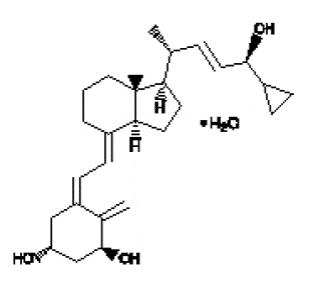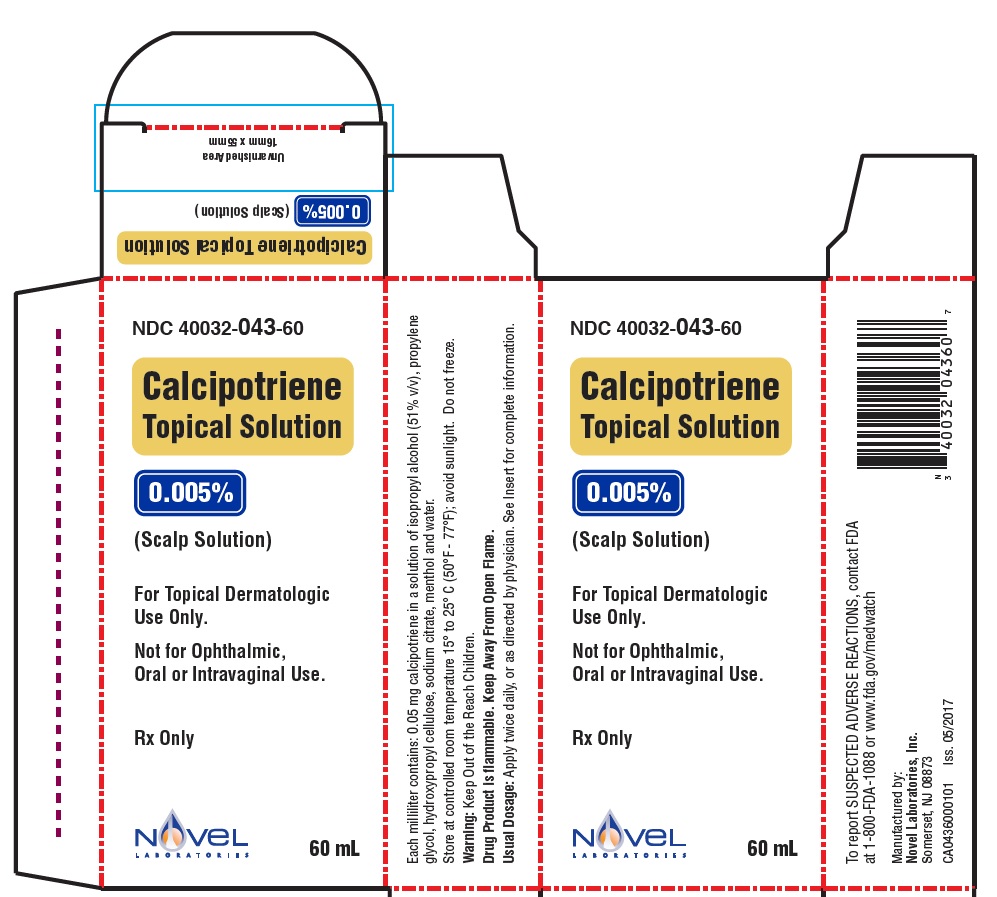Calcipotriene by Novel Laboratories, Inc. CALCIPOTRIENE solution
Calcipotriene by
Drug Labeling and Warnings
Calcipotriene by is a Prescription medication manufactured, distributed, or labeled by Novel Laboratories, Inc.. Drug facts, warnings, and ingredients follow.
Drug Details [pdf]
-
DESCRIPTION
Calcipotriene Topical Solution, 0.005% (Scalp Solution) is a colorless topical solution containing 0.005% Calcipotriene in a vehicle of isopropanol (51% v/v), propylene glycol, hydroxypropyl cellulose, sodium citrate, menthol and water.
Chemically, calcipotriene monohydrate is (5Z,7E,22E,24S)-24-cyclopropyl-9,10-secochola-5,7,10(19),22-tetraene-1α,3β,24-triol monohydrate, with the empirical formula C27H40O3.H2O a molecular weight of 430.6, and the following structural formula:

-
CLINICAL PHARMACOLOGY
In humans, the natural supply of vitamin D depends mainly on exposure to the ultraviolet rays of the sun for conversion of 7-dehydrocholesterol to vitamin D3 (cholecalciferol) in the skin. Calcipotriene is a synthetic analog of vitamin D3.
Although the precise mechanism of calcipotriene's antipsoriatic action is not fully understood, in vitro evidence suggests that calcipotriene is roughly equipotent to the natural vitamin in its effects on proliferation and differentiation of a variety of cell types. Calcipotriene has also been shown, in animal studies, to be 100-200 times less potent in its effects on calcium utilization than the natural hormone.
Clinical studies with radiolabelled calcipotriene solution indicate that less than 1% of the applied dose of calcipotriene is absorbed through the scalp when the solution (2.0 mL) is applied topically to normal skin or psoriasis plaques (160 cm2) for 12 hours, and that much of the absorbed calcipotriene is converted to inactive metabolites within 24 hours of application.
Vitamin D and its metabolites are transported in the blood, bound to specific plasma proteins. The active form of the vitamin, 1,25-dihydroxy vitamin D3 (calcitriol), is known to be recycled via the liver and excreted in the bile. Calcipotriene metabolism following systemic uptake is rapid, and occurs via a similar pathway to the natural hormone. The primary metabolites are much less potent than the parent compound.
There is evidence that maternal 1,25-dihydroxy vitamin D3 (calcitriol) may enter the fetal circulation, but it is not known whether it is excreted in human milk. The systemic disposition of calcipotriene is expected to be similar to that of the naturally occurring vitamin.
-
CLINICAL STUDIES
Adequate and well-controlled trials of patients treated with Calcipotriene Topical Solution, 0.005% (Scalp Solution), have demonstrated improvement usually beginning after 2 weeks of therapy. This improvement continued with approximately 31% of patients appearing either cleared (14%) or almost cleared (17%) after 8 weeks of therapy.
- INDICATIONS AND USAGE
-
CONTRAINDICATIONS
Calcipotriene Topical Solution, 0.005% (Scalp Solution) is contraindicated in those patients with acute psoriatic eruptions or a history of hypersensitivity to any of the components of the preparation. It should not be used by patients with demonstrated hypercalcemia or evidence of vitamin D toxicity.
- WARNINGS
-
PRECAUTIONS
General
Use of Calcipotriene Topical Solution, 0.005% (Scalp Solution) may cause transient irritation of both lesions and surrounding uninvolved skin. If irritation develops, Calcipotriene Topical Solution, 0.005% (Scalp Solution) should be discontinued.
For external use only. Keep out of the reach of children. Always wash hands thoroughly after use.
Reversible elevation of serum calcium has occurred with use of topical calcipotriene. If elevation in serum calcium outside the normal range should occur, discontinue treatment until normal calcium levels are restored.
Information for Patients
Patients using Calcipotriene Topical Solution, 0.005% (Scalp Solution) should receive the following information and instructions:
- This medication is to be used only as directed by the physician. It is for external use only. Avoid contact with the face or eyes. As with any topical medication, patients should wash their hands after application.
- This medication should not be used for any disorder other than that for which it was prescribed.
- Patients should report to their physician any signs of adverse reactions.
- Patients that apply Calcipotriene to exposed portions of the body should avoid excessive exposure to either natural or artificial sunlight (including tanning booths, sun lamps, etc.).
Carcinogenesis, Mutagenesis, Impairment of Fertility
When calcipotriene was applied topically to mice for up to 24 months at dosages of 3, 10 and 30 μg/kg/day (corresponding to 9, 30 and 90 μg/m2/day), no significant changes in tumor incidence were observed when compared to control. In a study in which albino hairless mice were exposed to both UVR and topically applied calcipotriene, a reduction in the time required for UVR to induce the formation of skin tumors was observed (statistically significant in males only), suggesting that calcipotriene may enhance the effect of UVR to induce skin tumors. Patients that apply calcipotriene to exposed portions of the body should avoid excessive exposure to either natural or artificial sunlight (including tanning booths, sun lamps, etc.). Physicians may wish to limit or avoid use of phototherapy in patients that use Calcipotriene Topical Solution, 0.005% (Scalp Solution).
Calcipotriene did not elicit any mutagenic effects in an Ames mutagenicity assay, a mouse lymphoma TK locus assay, a human lymphocyte chromosome aberration assay, or in a micronucleus assay conducted in mice.
Studies in rats at doses up to 54 μg/kg/day (324 μg/m2/day) of calcipotriene indicated no impairment of fertility or general reproductive performance.
Pregnancy
Teratogenic Effects: Pregnancy Category C
Studies of teratogenicity were done by the oral route where bioavailability is expected to be approximately 40-60% of the administered dose. Increased rabbit maternal and fetal toxicity was noted at 12 μg/kg/day (132 μg/m2/day). Rabbits administered 36 μg/kg/day (396 μg/m2 /day) resulted in fetuses with a significant increase in the incidences of pubic bones, forelimb phalanges, and incomplete bone ossification. In a rat study, oral doses of 54 μg/kg/day (318 μg/m2/day) resulted in a significantly higher incidence of skeletal abnormalities consisting primarily of enlarged fontanelles and extra ribs. The enlarged fontanelles are most likely due to calcipotriene's effect upon calcium metabolism. The maternal and fetal calculated no-effect exposures in the rat (43.2 μg/m2/day) and rabbit (17.6 μg/m2/day) studies are greater than the expected human systemic exposure level (0.13 μg/m2 /day) from dermal application. There are no adequate and well-controlled studies in pregnant women. Therefore, Calcipotriene Topical Solution, 0.005% (Scalp Solution) should be used during pregnancy only if the potential benefit justifies the potential risk to the fetus.
Nursing Mothers
There is evidence that maternal 1,25-dihydroxy vitamin D3 (calcitriol) may enter the fetal circulation, but it is not known whether it is excreted in human milk. The systemic disposition of calcipotriene is expected to be similar to that of the naturally occurring vitamin. Because many drugs are excreted in human milk, caution should be exercised when Calcipotriene Topical Solution, 0.005% (Scalp Solution), is administered to a nursing woman.
Pediatric Use
Safety and effectiveness of Calcipotriene Topical Solution, 0.005% (Scalp Solution) in pediatric patients have not been specifically established. Because of a higher ratio of skin surface area to body mass, pediatric patients are at greater risk than adults of systemic adverse effects when they are treated with topical medication.
Geriatric Use
Of the total number of patients in clinical studies of calcipotriene solution, approximately 16% were 65 or older, while approximately 4% were 75 and over. The results of an analysis of severity of skin-related adverse events showed no differences for subjects over 65 years compared to those under 65 years, but greater sensitivity of some older individuals cannot be ruled out.
-
ADVERSE REACTIONS
In controlled clinical trials, the most frequent adverse reactions reported to be related to Calcipotriene Topical Solution, 0.005% (Scalp Solution), use were transient burning, stinging and tingling, which occurred in approximately 23% of patients. Rash was reported in about 11% of patients. Dry skin, irritation and worsening of psoriasis were reported in 1-5% of patients. Skin atrophy, hyperpigmentation, hypercalcemia, and folliculitis were not observed in these studies, but cannot be excluded.
-
OVERDOSAGE
Topically applied calcipotriene can be absorbed in sufficient amounts to produce systemic effects. Elevated serum calcium has been observed with excessive use of topical calcipotriene. If elevation in serum calcium should occur, discontinue treatment until normal calcium levels are restored. (See PRECAUTIONS.)
-
DOSAGE AND ADMINISTRATION
Comb the hair to remove scaly debris and after suitably parting, apply Calcipotriene Topical Solution, 0.005% (Scalp Solution), twice daily, only to the lesions, and rub in gently and completely, taking care to prevent the solution spreading onto the forehead. The safety and efficacy of Calcipotriene Topical Solution, 0.005% (Scalp Solution), have been demonstrated in patients treated for eight weeks.
Keep Calcipotriene Topical Solution, 0.005% (Scalp Solution) well away from the eyes. Avoid application of the solution to uninvolved scalp margins. Always wash hands thoroughly after use.
- HOW SUPPLIED
- STORAGE
- PACKAGE LABEL.PRINCIPAL DISPLAY PANEL
-
INGREDIENTS AND APPEARANCE
CALCIPOTRIENE
calcipotriene solutionProduct Information Product Type HUMAN PRESCRIPTION DRUG Item Code (Source) NDC: 40032-043 Route of Administration TOPICAL Active Ingredient/Active Moiety Ingredient Name Basis of Strength Strength CALCIPOTRIENE (UNII: 143NQ3779B) (CALCIPOTRIENE - UNII:143NQ3779B) CALCIPOTRIENE 0.05 mg in 1 mL Inactive Ingredients Ingredient Name Strength PROPYLENE GLYCOL (UNII: 6DC9Q167V3) ISOPROPYL ALCOHOL (UNII: ND2M416302) MENTHOL (UNII: L7T10EIP3A) HYDROXYPROPYL CELLULOSE, LOW SUBSTITUTED (UNII: 2165RE0K14) WATER (UNII: 059QF0KO0R) SODIUM CITRATE (UNII: 1Q73Q2JULR) Packaging # Item Code Package Description Marketing Start Date Marketing End Date 1 NDC: 40032-043-60 1 in 1 CARTON 12/26/2017 1 60 mL in 1 BOTTLE; Type 0: Not a Combination Product Marketing Information Marketing Category Application Number or Monograph Citation Marketing Start Date Marketing End Date ANDA ANDA207163 12/26/2017 Labeler - Novel Laboratories, Inc. (793518643) Registrant - Novel Laboratories, Inc. (793518643) Establishment Name Address ID/FEI Business Operations Novel Laboratories, Inc. 793518643 ANALYSIS(40032-043) , MANUFACTURE(40032-043) , PACK(40032-043)
© 2025 FDA.report
This site is not affiliated with or endorsed by the FDA.

